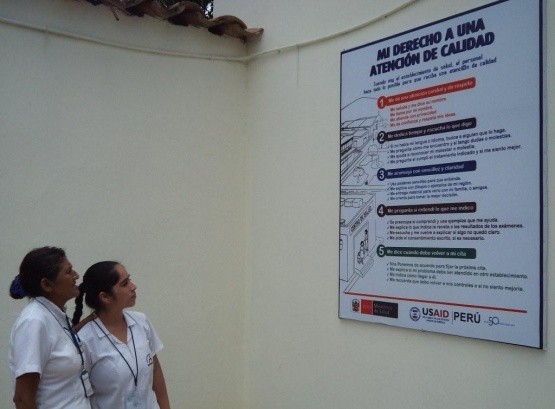
Many rural health facilities in Peru face the challenge of providing quality maternal-child health services. However, the Lluyllucucha health micro-network in San Martin, Peru, has reason to be proud. Since January 2010, the maternal mortality rate has been zero.
In addition, from May 2009 to November 2011, births attended by skilled personnel increased from 52 to 90 percent; prenatal care rates increased from 55 to 82 percent; child immunization increased from 80 to 98 percent; teenage pregnancy decreased from 28 to 12 percent; and the number of cases of infants with diarrhea fell from 4 percent to just 1 percent.
The network’s Flor de Primavera health post is a shining example of positive change resulting from committed staff and performance improvement.
Senaida Mariñas is the health technician in charge of the facility. “In 2009, when I first came here, there wasn’t a dirt road for cars,” she says. “I am the only one who works here and I see an average of 20 to 25 patients daily and serve a population of about 1,100 people. Some bet I would stay for three days, others said a week. Everyone has been surprised that I am still here after four years.”
Since 2009, USAID/Peru has provided technical assistance to the Lluyllucucha micro-network to implement performance improvement methodology (PIM) at their 11 health posts, two health centers, and one community pharmacy. Under the methodology, best practices proven to strengthen health outcomes are monitored, assessed and put into action. Network improvement plans have focused on standardizing services, organizing patient visits, guaranteeing patient privacy, and promoting facility sanitation procedures to provide quality health care to 26,000 people from the Peruvian Amazon.
The performance improvement methodology includes a guide to community action. This guide has helped health personnel like Mariñas to effectively interact with community leaders, turning Flor de Primavera into a model health post that exemplifies effective coordination. By seeking support from local authorities and midwives, the health post has seen an increase in demand for health services and undertaken further quality improvements.
The process has relied heavily on the invaluable commitment of health-care staff who have made patient satisfaction a priority. These staff use best practice guides when providing day-to-day services and when training new employees.
Performance improvement is now a daily activity. “It allows us to satisfy users, prevent illnesses, and improve our technical capabilities,” notes Dr. Marcia Rios Noriega, head of the Lluyllucucha micro-network. “In 2008, we were only attending 52 percent of pregnant women in the area, and in October of 2012, we were seeing 96 percent of them. We no longer have maternal deaths in this area. We are saving children from chronic malnutrition. What motivates the staff now is their good performance.”
The support was part of the USAID/Peru Quality Healthcare program, which was designed to improve the delivery of health services by the Ministry of Health and selected regional and local governments. The program, which ran from July 2008 to July 2013, focused on services for maternal and child health, family planning and reproductive health, and the prevention and control of infectious diseases such as HIV/AIDS, tuberculosis and intra-hospital infection.







Comment
Make a general inquiry or suggest an improvement.